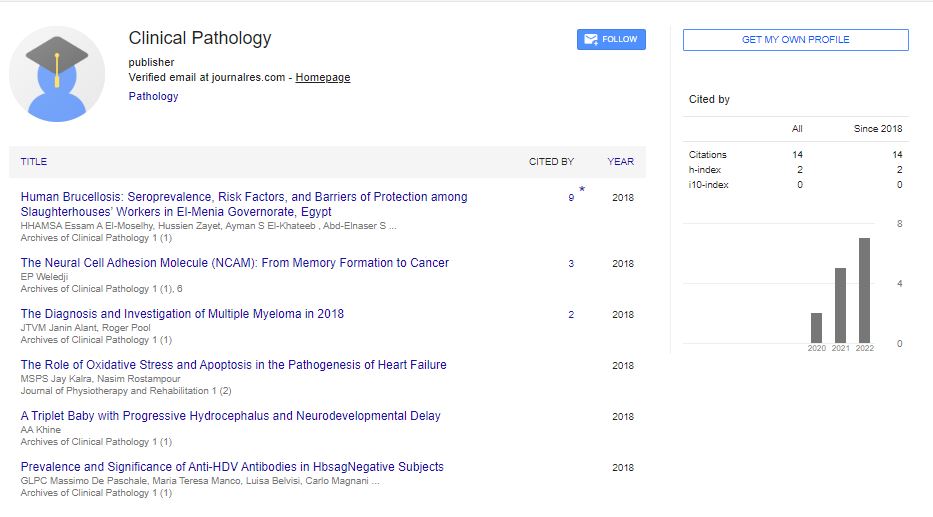Opinion Article, Arch Clin Pathol Vol: 6 Issue: 1
Exploring the Causes and Consequences of Neuropathological Diseases
German Laura*
Department of Neurology, University of Pennsylvania, Philadelphia, United States
*Corresponding Author: German Laura
Department of Neurology University of Pennsylvania, Philadelphia, United States
E-mail: laurag@unf33.edu
Received date: 20 February, 2023, Manuscript No. ACPY-23-96315;
Editor assigned date: 22 February, 2023, PreQC No. ACPY-23-96315 (PQ);
Reviewed date: 09 March, 2023, QC No. ACPY-23-96315;
Revised date: 16 March, 2023, Manuscript No. ACPY-23-96315 (R);
Published date: 23 March, 2023, DOI: 2324-8955/acpy.05.03.100080
Citation: Laura G (2023) Exploring the Causes and Consequences of Neuropathological Diseases. Arch Clin Pathol 6:1.
Keywords: Neuropathological
Description
Neuropathological diseases refer to conditions that affect the nervous system, specifically the brain and spinal cord. These conditions can lead to a wide range of symptoms, such as muscle weakness, difficulty with coordination, memory loss, and cognitive impairment. In adults, neuropathological diseases are a significant cause of disability and death, and they can have a significant impact on the quality of life for affected individuals and their families. Alzheimer's disease is a progressive neurodegenerative disorder that affects millions of adults worldwide. It is the leading cause of dementia, accounting for 60% –80% of cases.
The disease is characterized by the accumulation of beta-amyloid plaques and neurofibrillary tangles in the brain, which lead to the death of neurons and the progressive loss of cognitive function. The most common symptoms of Alzheimer's disease include memory loss, difficulty with language, impaired judgement, and personality changes. There is currently no cure for Alzheimer's disease, but medications and other therapies can help manage the symptoms and slow the progression of the disease.
Parkinson's disease is another common neuropathological disease that affects millions of adults worldwide. It is a progressive disorder that primarily affects the motor system, leading to tremors, stiffness, and difficulty with movement. Parkinson's disease is caused by the loss of dopamine-producing neurons in the brain, which leads to an imbalance in the neurotransmitters that control movement.
In addition to motor symptoms, Parkinson's disease can also lead to cognitive impairment, depression, and other non-motor symptoms. Multiple sclerosis is a chronic autoimmune disorder that affects the central nervous system. It is caused by the immune system attacking the myelin sheath that surrounds and protects nerve fibers in the brain and spinal cord. This leads to a wide range of symptoms, including muscle weakness, difficulty with coordination, and problems with vision, speech, and cognition.
The symptoms of multiple sclerosis can vary widely between individuals and can be unpredictable in their severity and progression. It has no cure, but medicines and other treatments can help regulate symptoms and limit the disease's progression. Amyotrophic Lateral Sclerosis (ALS), also known as Lou Gehrig's disease, is a progressive neurodegenerative disorder that affects the motor neurons in the brain and spinal cord. This leads to muscle weakness, difficulty with movement, and eventual paralysis. ALS is caused by a combination of genetic and environmental factors, and it is often fatal within a few years of diagnosis.
There is no cure for ALS, but medications and other treatments can help manage the symptoms and prolong survival. Huntington's disease is a genetic disorder that affects the brain and causes progressive motor, cognitive, and psychiatric symptoms. The disease is caused by a mutation in the huntingtin gene, which leads to the accumulation of abnormal proteins in the brain. The symptoms of Huntington's disease typically begin in middle age and progress slowly over the course of 10-25 years. There is no cure for Huntington's disease, but medications and other treatments can help manage the symptoms and improve quality of life.
Conclusion
Neuropathological diseases are a significant cause of disability and death in adults, and they can have a profound impact on the lives of affected individuals and their families. While there is no cure for most neuropathological diseases, medications and other treatments can help manage the symptoms and slow the progression of the disease. Early diagnosis and treatment are essential in improving outcomes for individuals with neuropathological diseases, and ongoing investigation is focused on developing new therapies that can target the underlying causes of these conditions.
 Spanish
Spanish  Chinese
Chinese  Russian
Russian  German
German  French
French  Japanese
Japanese  Portuguese
Portuguese  Hindi
Hindi 